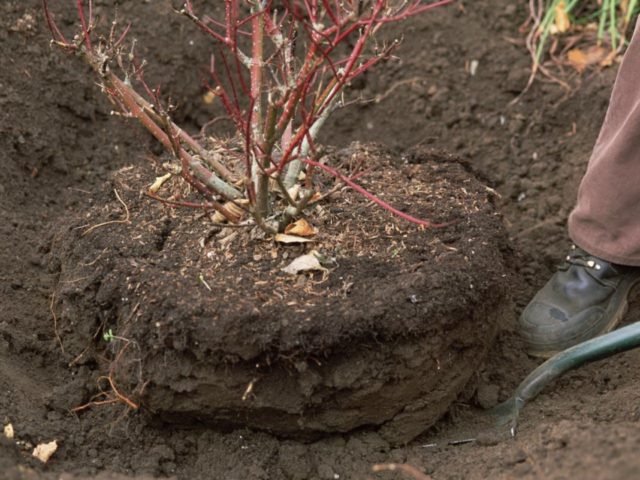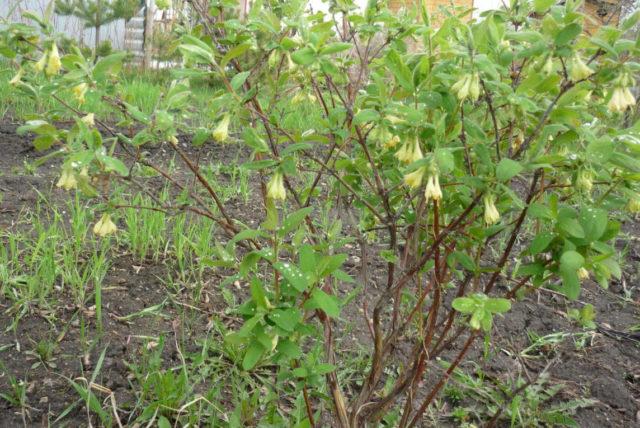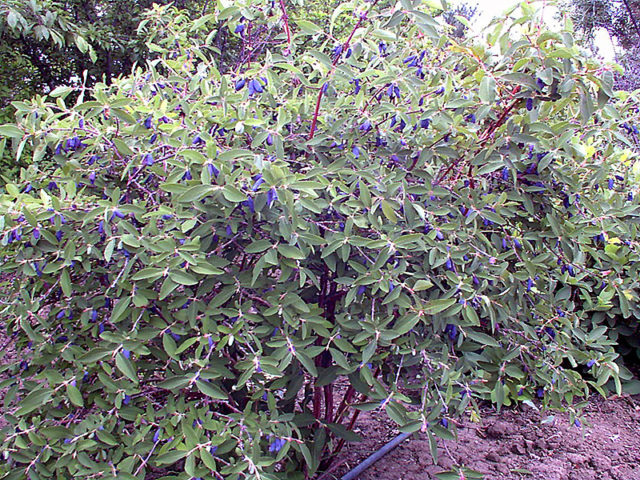Content
- 1 When can you transplant honeysuckle bushes
- 2 Is it possible to transplant honeysuckle during flowering
- 3 Is it possible to divide a honeysuckle bush for transplant
- 4 How to dig up honeysuckle for transplant
- 5 How to transplant a honeysuckle bush to another location
- 6 Rules for caring for a transplanted honeysuckle bush
- 7 Experienced gardening tips
- 8 Conclusion
You can transplant honeysuckle at any age, but it is better to choose a favorable season when the plant is dormant. When moving, the bush is divided or transferred to a new site entirely. They pay main attention to the proper care of the plant, since the survival rate depends on it.

After transplanting adult honeysuckle bushes, fruits can be obtained the next year, subject to the main agrotechnical conditions
When can you transplant honeysuckle bushes
Honeysuckle is an unpretentious plant. The transplant is tolerated at almost any stage of development, and when agrotechnical conditions are fulfilled, it can be transferred throughout the entire warm season: early spring, summer, autumn. Each transplant period has its own characteristics, which are carefully studied. Development and fruiting depend on compliance with the requirements.
The autumn period, when the plant has already entered the resting phase, is considered especially favorable for transplanting an adult honeysuckle bush. In the spring, it is not recommended to move the crop due to the early start of the growing season, the bush dissolves dormant buds at the slightest warming.
Honeysuckle is transplanted for the following reasons:
- the bush has developed and became spreading;
- oppresses neighboring plants that are more valuable for the gardener;
- tall trees began to shade the honeysuckle, and the culture bears fruit well only with sufficient sunlight.
Is it possible to transplant honeysuckle during flowering
Experienced gardeners advise against replanting old honeysuckle bushes during flowering. The procedure has a bad effect on survival and subsequent fruiting for 1-2 years. It is better to move the honeysuckle before the buds begin to swell, as soon as it will be possible to work in the garden after the snow has melted.
Is it possible to divide a honeysuckle bush for transplant
Often honeysuckle grows in the form of a tree with one trunk, and then division is impossible. But if several shoots depart from the fibrous root, new seedlings are obtained. The root ball is cut with a sharp, disinfected shovel, the processes are transplanted separately.
Delenki are treated with disinfectant and fungicide.
The root system of honeysuckle is densely fibrous, superficial, located in a layer of soil up to 15-25 cm deep. Under favorable conditions, the bush quickly takes root in a new place.
How to dig up honeysuckle for transplant
When transplanting an adult bush, carefully examine the honeysuckle crown, remove old, broken and thickening branches that grow inward. Culture up to 5-6 years old is not cut off. Before moving, watered abundantly 1-2 days before the procedure, so that the ground is not solid, but slightly damp, and the root ball is tightly connected to the enclosing soil.
The roots of honeysuckle are superficial, not single, but with numerous small shoots, which it is advisable not to damage and preserve:
- the bushes are dug in from all sides, stepping back from the trunk by 40-50 cm, to a depth of 30 cm;
- then dig under the center of the root ball;
- they are lifted and taken out together with the soil onto a previously prepared dense film or fabric;
- they do not shake the ground from under the roots, trying to keep a lump in order to less disturb the small root processes;
- the honeysuckle is dragged or transferred and carefully placed in the prepared planting pit.
When replanting honeysuckle, they concentrate on carefully digging up and gently moving the plant. After transshipment, possible remnants of root shoots in the same place in favorable conditions grow into full-fledged seedlings for the next year.

The preserved roots and ground part tolerate movement painlessly
How to transplant a honeysuckle bush to another location
Before transplanting a shrub, a place is found that meets all agrotechnical requirements:
- a bright, well-lit area with the sun;
- there are no drafts and sharp gusts of wind;
- the soil can be low-lying, but not swampy, because excess moisture entails rotting of the roots;
- the soil is light in structure, with low acidity;
- the distance to neighboring bushes is 1.5-2 m.
Good neighbors for the culture are currants, chubushnik, lilacs, which with thick foliage protect honeysuckle from strong winds. A prerequisite for yield is planting 3-6 or more seedlings of different varieties to ensure effective cross-pollination.
When transplanting an adult bush, honeysuckle improves the conditions for development - they are moved into a hole, which is larger in volume than the previous one. Filling the planting site with a substrate, make sure that the soil is loose, with a large proportion of sand, to which peat, humus and garden soil are also added in equal proportions.
Prepare a hole for honeysuckle according to the same requirements for all seasonal transplantation periods:
- they dig a hole in 7-10 days to a depth of 30-40 cm, a width of 45-50 cm, along the width of a bush for transplanting;
- lay a drainage layer 10-12 cm thick;
- mix the necessary constituent parts of the substrate, respectively, the soil on the site, adding humus or compost;
- enrich the soil in the pit 3-4 tbsp. l. superphosphate, 2 tbsp. l. potassium sulfate, 1 tbsp. l. ammonium nitrate;
- if the soil is acidic, the substrate is lime - add 200-400 g of dolomite flour or slaked lime.
When transplanting, the honeysuckle root collar should be at the same level as before, above the garden soil. The plant is watered with 1-2 buckets of water, depending on the size of the root system. The trunk circle is mulched with straw, hay, peat, humus.
How to transplant honeysuckle to a new location in the spring
Honeysuckle transplant in the spring is carried out only in case of emergency. Carefully dig in an earthen ball with a root system, if possible without damage, and transfer it to the nearest planting site. It is not recommended to transport seedlings with open roots over long distances. Most often, such plants lag behind in development. If wintering is successful, honeysuckle will grow in a year.

The buds of the culture begin to awaken very early, back in March
There are varieties with a late start of the growing season and, accordingly, late fruiting, which can be moved in the spring. Most of the common varieties of honeysuckle bloom as early as April, just during gardening. From the video it is clear how to properly transplant honeysuckle in the spring:
How to transplant honeysuckle to another location in the summer
Berries ripen early on the bush - in June. And after harvesting, a more successful transplant is possible if the roots are carefully dug up. Early varieties of honeysuckle are easy to transplant in August, because the growth of shoots stops in the culture already in July. Before transplanting, dry and broken shoots and branches are removed. Young seedlings from containers tolerate summer transplantation without problems.
For plants moved in summer, it is important to create the most comfortable conditions:
- shading on hot August days;
- regular abundant watering;
- mulching the trunk circle.
How to properly transplant honeysuckle in the fall
The culture is often transplanted from the end of summer, when the growth of shoots stops and a period of calm begins. The timing of the transplant of honeysuckle in the fall differ according to the geographical features of the climate:
- in most central regions and similar to them in the weather - from late August to mid-October;
- in the south - until mid-November;
- in the northern regions - until mid-September.
With a timely autumn transplant of honeysuckle in the days remaining before frost, the shrub manages to take root.
Rules for caring for a transplanted honeysuckle bush
It is important not only to preserve the roots and choose a suitable site, but also the subsequent care of the shrub. There are also features of agricultural technology, depending on the growing region:
- in areas with a long warm autumn, varieties with a long dormant period are selected so that the buds do not bloom in November or during winter thaws after an early autumn transplant;
- in the southern Ural region with high summer temperatures, it is recommended to transplant honeysuckle in partial shade and abundant watering in June, during the ripening phase of berries, as well as the obligatory mulching of the trunk circle to protect the superficial root system from overheating;
- replanting honeysuckle in Siberia is advised mainly in autumn or with abundant watering in spring and early summer;
- in regions with severe long winters and a short warm period, it is impossible to add nitrogen preparations to the planting pit or feed the plants with them during the second half of summer.
Plants after transplantation are abundant, but rarely watered, in the middle lane 2-3 times per season are enough, especially in the ripening phase of berries. For each bush give 10-15 liters, taking into account the size of the plant. Watering in the south is carried out regularly throughout the growing season, during the ripening of berries up to 2 times a week, 15 liters per plant. And in the fall, in the middle, end of September or October, depending on the climate, they do moisture charging, at the same time pouring up to 30 liters of water under the bushes. The slightly dried soil is loosened so that a crust does not form, and oxygen penetrates to the roots. Weed shallow because of the surface roots.
The culture is fed once every 3-4 years with organic matter or mineral preparations for berry bushes. In April, fertilizers are simply placed on the snow in the trunk circle. They start pruning branches 5 years after the honeysuckle transplant. Young shoots are not removed as they are fruitful.

When transplanting, take into account that there should be 4-5 different varieties nearby for good yields
Experienced gardening tips
Work with honeysuckle for transplantation and care is carried out based on knowledge of the characteristics of the bush:
- the buds on the plant awaken at + 3 ° С, and flowering begins at + 9 ° С;
- growth is formed in April and early May;
- flower buds of the future harvest are created at the end of May;
- berries are formed on the shoots of the last year, therefore, rare pruning is done very carefully, removing only damaged branches;
- on young branches 15-25 cm long, from 18 to 45 fruits are tied, and on old branches fruiting shoots are short, up to 5 cm with 2-4 berries.
Conclusion
It is not difficult to transplant honeysuckle, because a well-preserved fibrous root system easily takes root. It is more important to choose a suitable site and properly care for the plant.








